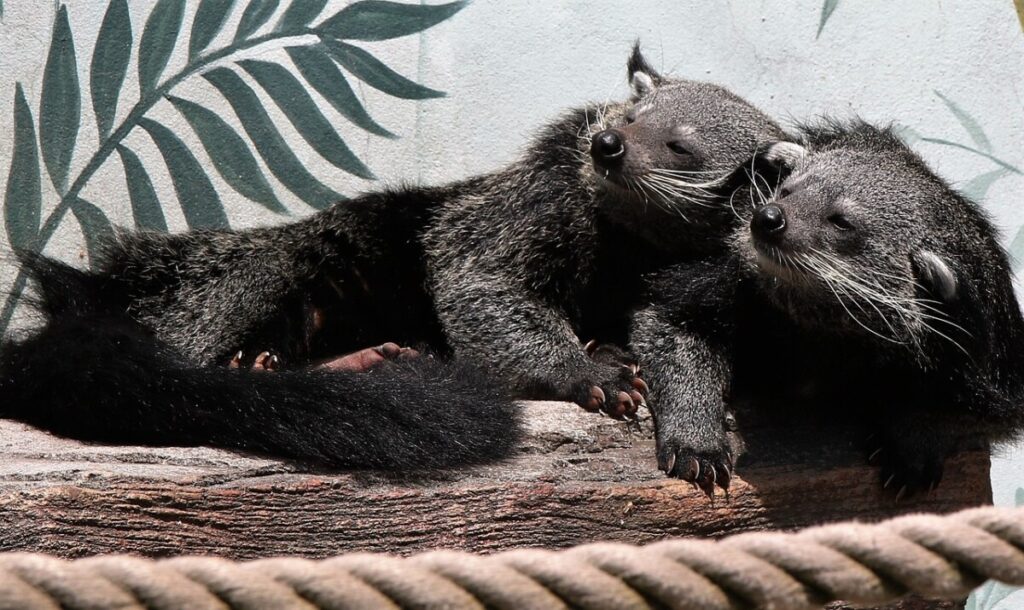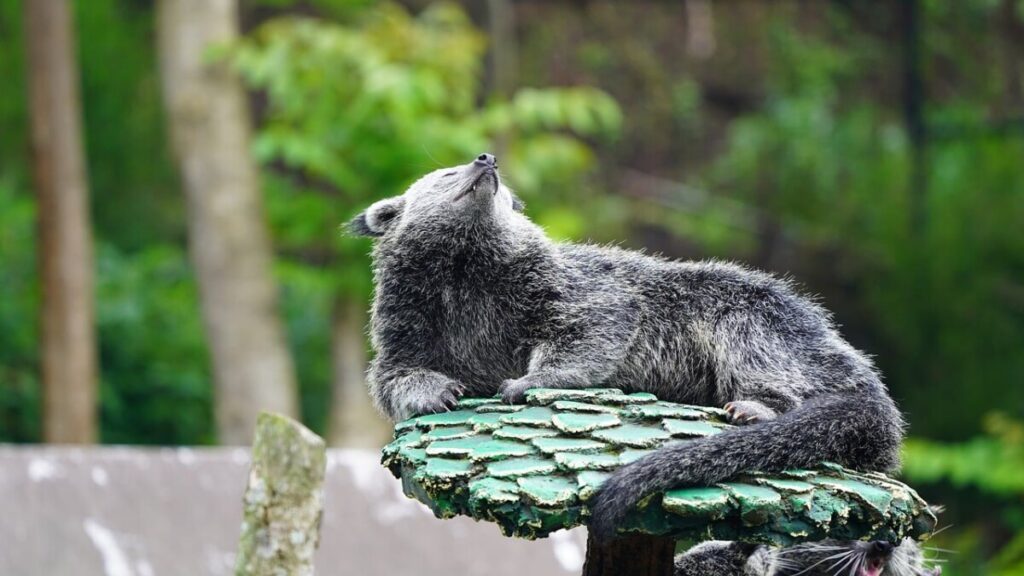The binturong (Arctictis binturong) also known as the bearcat, is a species of viverrid native to South and Southeast Asia. It has been listed as Vulnerable on the International Union for Conservation of Nature (IUCN) Red List since 2008, due to its decreasing population in the wild. This article will discuss the physical characteristics, range and habitat, behavior, diet and conservation status of this unique animal.
Binturongs have a long body with short legs covered in thick fur that often appears black but may vary from dark brown to light grey or even reddish-brown depending on the individual’s age and sex.
They possess an impressive prehensile tail which can be used like a fifth limb when climbing trees or grabbing branches. Their faces are elongated with small ears set close together atop their heads.
They also have powerful claws which allow them to climb tree trunks easily despite their relatively small size compared to other members of their family.
Within its range, binturongs inhabit lowland forests up to elevations of 1,800 metres above sea level. Generally they prefer areas near rivers or streams where there is plenty of food available such as fruits, insects and small animals.
Binturongs spend most of their time high up in trees hunting during dusk and dawn while sleeping through much of the day though solitary individuals may occasionally be seen out during daylight hours. As nocturnal creatures they rely heavily on smell and hearing rather than sight to locate prey items and navigate around obstacles in their environment.

What Is A Binturong?
Binturongs are a species of mammals that belong to the Viverridae family. They have an elongated body shape, with a long tail and black-brown fur. The head is round and they have small ears. Binturongs weigh up to 30 pounds and can reach lengths of between two and three feet in length, including their tails.
The natural habitat of binturongs includes tropical rainforests, mangroves and subtropical forests. They are primarily nocturnal creatures but will occasionally be active during the day when food resources become scarce or weather conditions dictate it is necessary for them to remain active in order to survive. Their diet consists mostly of fruits, flowers, bird eggs, reptiles, insects, birds and small mammals such as rodents.
Binturongs typically live alone or in pairs but may also form larger social groups when food is plentiful. In areas where there is abundant food supply they tend to travel within large territories while defending these regions from intruders by using loud vocalizations and scent marking with urine.
Breeding season occurs annually during the summer months when females give birth to one or two young after a gestation period of approximately six weeks following which mothers provide care for four to five months until their offspring is fully weaned and independent enough to fend for itself in its environment.
Physical Characteristics Of Binturongs
Binturongs are fascinating animals, and their physical characteristics can be quite interesting. The average binturong weighs between 11-16 lbs., with a body length of about 24 inches long, and an additional tail length of 25-30 inches long.
Their fur is coarse in texture and typically ranges from dark brown to black in color. Binturongs have round heads, small eyes, large ears, and short snouts which contain specialized scent glands that help them mark their territory with a strong odor resembling popcorn.
Their sharp claws make it easy for binturongs to climb trees as they have semi-retractable digits like cats do. These mammals also have the ability to rotate their ankles 180° allowing them to hang upside down while clinging to branches. Additionally, binturongs possess the remarkable ability to swim; this allows them to traverse rivers or other bodies of water if needed.
Binturongs have several adaptations that enable them to live successfully both on land and in trees; these include powerful muscles used for climbing as well as thick fur which helps keep them warm when temperatures drop at night.
Furthermore, their sharp claws aid in maintaining balance while navigating through tree canopies and provide protection against potential predators such as leopards or tigers. Lastly, their sense of smell plays a vital role in locating food sources and marking territories during mating season.
Natural Habitat Of Binturongs
The natural habitat of binturongs is an important part of their ecology. Binturongs are native to tropical and subtropical regions in Southeast Asia, including Bangladesh, Cambodia, India, Indonesia, Laos, Malaysia, Myanmar (Burma), Thailand and Vietnam.
These animals prefer lowland forests or other areas with dense vegetation such as swamps. They usually inhabit the lower canopy levels of these habitats and sometimes even enter into mangrove swamps near coastal areas.
Binturongs also have unique adaptations that allow them to survive in their forest environment. For example, they possess a strong sense of smell which helps them detect food sources from far away distances. Additionally, their semi-retractable claws enable them to climb trees easily and quickly move through the canopy layers for protection against potential predators on land or in the air.
Furthermore, their long prehensile tails help provide balance when climbing up branches and can be used as an extra limb when descending from high places. This allows binturongs to explore different parts of their environment while avoiding danger or capture by humans or other animals.
Due to human activities such as deforestation and hunting, binturong populations have declined significantly over recent decades.
As a result of this decline in numbers along with its restricted geographic range, this species has been listed as Vulnerable by the International Union for Conservation of Nature Red List since 2008. Therefore it is essential that conservation efforts continue so that future generations may benefit from the presence of these fascinating mammals in their natural habitat.
Diet And Eating Habits Of Binturongs
Binturongs, also known as bearcats, are omnivorous mammals found in the wild throughout Southeast Asia. As such, their diet consists of a variety of different types of food sources. The majority of their diet is made up of fruits and vegetation, but they will also consume small animals like reptiles, birds, fish and eggs when available. They have been observed to eat insects such as grasshoppers and crickets as well.
In addition to hunting for their prey, binturongs are opportunistic feeders who take advantage of whatever food source is most readily available. This includes scavenging on carrion or raiding crops from nearby farms or gardens if there is not enough natural food around them. Binturongs can even climb trees in search of fruit or other items that may be located higher up than ground level.
They mainly consume their meals at night time but can often be spotted during the day hours too, depending on how much activity there is within the area where they live. Binturong’s digestive system processes both plant material and animal protein with ease due to its dual-chambered stomach which allows it to break down large chunks of food more effectively than some other species would be able to do alone.
Unique Adaptations Of Binturongs
Binturongs possess several unique adaptations that allow them to thrive in their natural habitat. A key adaptation of the species is its long, prehensile tail which functions as a fifth limb and allows them to move through the trees with ease.
This helps binturongs explore and forage efficiently while avoiding predators on the ground. Furthermore, they have strong claws that are well suited for climbing trees, allowing these animals to access food sources high up in the canopy.
The nocturnal nature of binturongs also provides an advantage over diurnal competitors when it comes to accessing resources such as fruits and foliage during the night-time hours. Additionally, their keen sense of smell assists them in locating food items from far away distances.
Another important adaptation is their ability to rotate their back legs 180 degrees so that they can grasp onto branches more securely when moving around in treetops. All these traits combined help binturongs successfully navigate and survive within their tropical rainforest environment.
These various physiological features demonstrate how binturong populations have evolved over time to become better adapted to life among the trees of their rainforest habitat.

Breeding And Reproduction Of Binturongs
Binturongs are solitary creatures, and typically breed only with one partner at a time. During the mating season, male binturons will mark their territory by scent-marking trees or other objects in order to attract mates. Female binturongs will then search for suitable males before mating.
The gestation period of female binturongs is approximately three months long, after which she gives birth to litters of two to four offspring. The female takes care of her young until they reach independence, usually around eight months of age. Binturong cubs have fully developed eyesight upon birth and can climb trees within days of being born.
Young binturong siblings often remain together in small family groups even when not under parental supervision; this behaviour has been observed as far away from the mother’s home range as seventy kilometres. Such social behaviours may help protect the cubs against potential predators while helping them learn survival skills more quickly than if they were alone.
Conservation Status Of Binturongs
The conservation status of binturongs is vulnerable according to the International Union for Conservation of Nature (IUCN). Binturong populations are threatened by habitat loss due to deforestation and fragmentation. In some areas, they are hunted for food or traditional medicine, while in other places they are captured as pets.
As a result, their numbers have decreased significantly since the 1990s when they were first listed on IUCN’s Red List of Threatened Species.
In order to help protect binturong populations, there has been an increase in conservation efforts across Southeast Asia. These include improved protection of existing habitats, reforestation projects, and anti-hunting programs aimed at providing education about protecting wildlife species like the binturong.
Captive breeding initiatives have also been put into place to ensure that viable populations remain in case wild ones become extinct.
As with many species around the world, human activities continue to be the biggest threats to binturong survival. Therefore it is essential that governments implement effective policies promoting responsible development practices so that natural ecosystems can be preserved and protected over time. If these steps are taken soon enough, hopefully more positive outcomes will be seen regarding this unique mammal’s future prospects.
